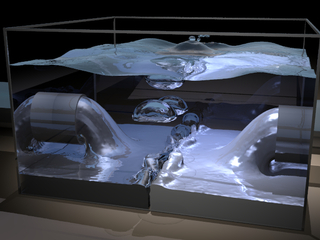watery simulations

water again: water simulations are cool. However the big question is: WHAT IS A SIMULATION? I.e. at what point do we accept a thing to look physically realistic? Do we want it to look realistic?
In the last weeks I was (on and off) writing on a short paper for the proceedings of the nmi 2006 conference. The paper (sofar only in german, english translation will follow) is more or less a description of our project seidesein, as seidesein was presented at this conference. Nonetheless – in this paper I tried not only to describe seidesein, but also tried to point at the issue of mathematical simulations, physical laws and the human perception.
We put many thoughts into that issue, when creating seidesein. Well the whole daytar site is about math/physics and perception and so i found it hard to squeeze even the most obvious major points into a few lines. On the other hand I had the feeling that a further explanation of the concepts behind our project was needed.
seidesein is not -yet another gadget-, it is rather a manifest of an ongoing exploration. The same holds e.g. for alphabet soup or surrealey. These 3 projects include water associations, yet we nowhere intended to model something realistically. On the contrary: we are playing with that connotation and I tried to illustrate in the paper why we want to play.
And coming back to the initially raised question “What is a simulation?”, I found this nice example of a real-time-canoe-in -water-simulation via we-make-money-not-art in a report about the next fest. The simulation seemed to work well as the reporter Peder was pleased.
In their description of the canoe project the researchers who created the simulation (on Soichi Hasegawa’s page) explained :
In developing Virtual Canoe, non-linear differential equations were converted into simple linear differential equations and a pre-computed database. Then the system ran them and found the difference between the simulation and the real phenomena, and corrected the simulator.
The development process demonstrates that creation of real-time simulations requires understanding real-world phenomena. Any research focused on undertanding real phenomena can be applied to create realistic virtual worlds, and virtual reality is a very good way to understand the real world. There are still many phenomena that cannot be portrayed in virtual worlds, but deeper understanding of the real world will expand virtual reality’s application and credibility.
Especially the statement “virtual reality is a very good way to understand the real world” is right one of the main points, which I tried to adress in my paper. In short – what I claim is: this statement is true to a certain extend, however it is a very very perception based approach.
Or in mathematical terms: The Navier-Stokes-Equations are one of the great mathematical mysteries and you can get 1 million $, if you make major advances in finding solutions. It is completely legitimate to OBSERVE how good a SIMULATION (of the equation as well as of the phenomena itself!) LOOKS like (and in a certain sense this is what physics is about) however it is related to HOW we look and WHICH data we collect. For a little contemplation about these issues this gorgeous little applet.
Remarks:
The above image is from Ron Fredkiw`s website, which bears a lot of supernice fuid simulations…however -for the time being -not in realtime….
seidesein will be on display in the trampoline night part of First play Berlin of trampoline/radiator (they have also water on their frontpage right now :)), Oct. 12 2006 at Hebbel theatre Berlin HAU 2.
Another project, which I would have liked to see or better hear at next fest: Nabzmob by Antoine Schmitt and Jean-Jacques Birgé…also if they have nothing to do with water…